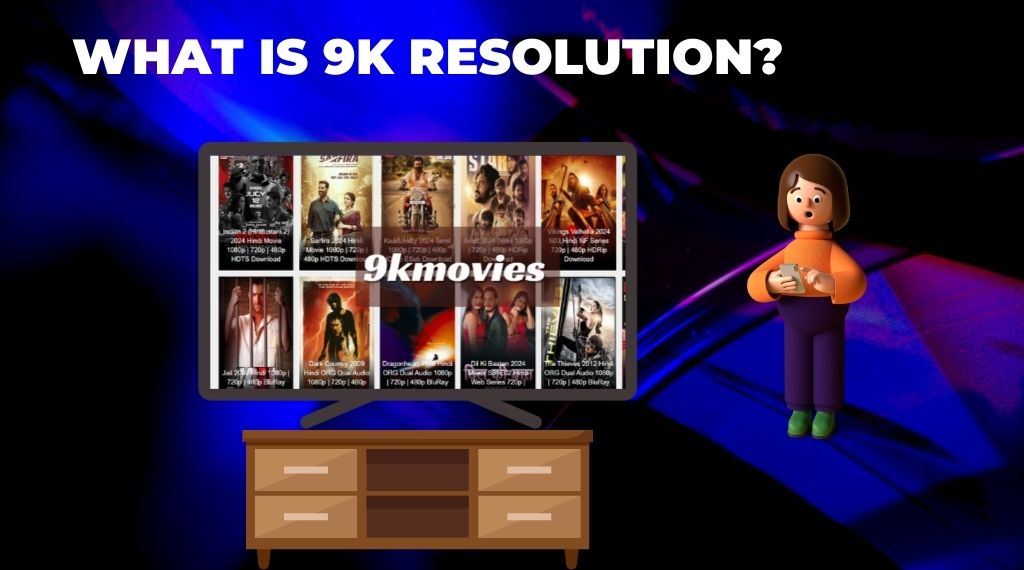The world of digital video is evolving at a rapid pace. From Standard Definition (SD) to 4K and 8K, each leap in resolution has brought sharper, more immersive viewing experiences. But what about 9K movies? Do they exist? Can you watch them at home? And how do they compare to other resolutions?
In this 2,000+ word guide, we’ll explore:
- What 9K resolution actually means
- Whether 9K movies are available for public viewing
- How 9K compares to 4K, 8K, and beyond
- Where you might encounter 9K content (IMAX, VR, experimental films)
- The future of ultra-high-definition movies
- Legal ways to experience near-9K quality
By the end, you’ll have a clear understanding of whether 9K movies are a reality—or just a futuristic concept.
What Is 9K Resolution?

Understanding Pixel Count
“9K” refers to a horizontal resolution of approximately 9,000 pixels. The exact dimensions can vary, but common 9K resolutions include:
- 8192 × 4320 (Digital Cinema 8K, sometimes called “9K”)
- 9000 × 5000+ (Experimental formats)
For comparison:
| Resolution | Pixel Count | Common Uses |
|---|---|---|
| 1080p (Full HD) | 1920 × 1080 | Blu-ray, streaming |
| 4K (UHD) | 3840 × 2160 | Netflix, UHD Blu-ray |
| 8K (UHD-2) | 7680 × 4320 | High-end TVs |
| 9K (Cinema) | 8192 × 4320+ | IMAX, professional filmmaking |
Is 9K Real for Consumers?
Currently, no consumer TVs or monitors support 9K. The highest available for home use is 8K, and even those are rare due to:
- Lack of native 8K/9K content
- Extremely high storage & bandwidth requirements
- Diminishing returns (human eye can’t easily distinguish beyond 8K on normal screens)
However, 9K is used in specialized fields like:
✅ IMAX theaters (some use 8K–12K laser projection)
✅ High-end VR and 360° video
✅ Professional filmmaking & CGI rendering
The Evolution of Movie Resolutions (SD to 9K)
To appreciate 9K, let’s look at how video resolution has progressed:
1. Standard Definition (SD) – 480p
- Resolution: 720 × 480 pixels
- Era: Early DVDs, analog TV
- Limitations: Blurry on modern screens
2. High Definition (HD) – 720p & 1080p
- 720p (1280 × 720): Early HDTV broadcasts
- 1080p (1920 × 1080): Blu-ray, YouTube, Netflix standard
3. Ultra HD (4K) – 2160p
- Resolution: 3840 × 2160
- Benefits: 4x sharper than 1080p, HDR support
- Adoption: Common in streaming (Disney+, Amazon Prime)
4. 8K – 4320p
- Resolution: 7680 × 4320
- Current Status: Limited content, few 8K TVs (Samsung QN900C)
5. 9K & Beyond
- 9K (8192 × 4320+): Mostly in IMAX & digital cinema
- 16K (15360 × 8640): Experimental (e.g., Japan’s NHK demos)
Can You Watch 9K Movies at Home?

Why 9K Isn’t Mainstream Yet
- No Consumer 9K TVs
- The best available is 8K (Samsung, LG).
- Manufacturing 9K screens is expensive and unnecessary for most homes.
- Massive File Sizes
- A 90-minute 9K movie could be 500GB–1TB+.
- Streaming would require 100+ Mbps internet.
- Limited Filmmaking in 9K
- Most movies are shot in 4K–8K, then mastered in 2K–4K.
- Only a few films (e.g., “Avatar” sequels) use 8K+ cameras.
Where 9K Content Exists Today
✔ IMAX Theaters (some use 8K–12K laser projection)
✔ High-End VR Films (Meta Quest Pro, Varjo headsets)
✔ Film Festivals & Demos (e.g., NHK’s 8K–16K showcases)
9K vs. 8K vs. 4K: Is There a Visible Difference?
| Factor | 4K | 8K | 9K |
|---|---|---|---|
| Pixel Count | 3840 × 2160 | 7680 × 4320 | 8192 × 4320+ |
| Best Screen Size | 55″–85″ | 75″–100″+ | 100″–IMAX |
| Human Eye Perception | Sharp | Extremely Sharp | No visible gain on normal screens |
| Content Availability | High (Netflix, Blu-ray) | Low (few 8K movies) | Rare (mostly IMAX) |
Key Takeaway:
- 9K is overkill for most TVs (you’d need a 150+ inch screen to notice a difference from 8K).
- IMAX & VR benefit most from ultra-high resolutions.
How to Experience Near-9K Quality Legally
Since 9K movies aren’t available for home viewing, here’s how to get the closest experience:
1. IMAX Theaters (Best Alternative)
- Films like “Dune” (2021) & “Interstellar” use 8K–12K digital IMAX.
- Laser IMAX offers higher dynamic range & resolution than standard theaters.
2. 8K TVs (Future-Proofing)
- Samsung QN900C (8K, AI upscaling)
- LG Z3 OLED (8K, perfect blacks)
3. High-End VR (For Immersive 9K-Like Content)
- Meta Quest Pro (supports high-res VR films)
- Pimax 8KX (dual 4K displays for near-9K clarity)
4. AI Upscaling (Enhancing 4K to Near-8K/9K)
- Topaz Video AI (upscales 4K → 8K)
- NVIDIA DLSS (AI-enhanced gaming at high res)
The Future of 9K Movies

While 9K isn’t mainstream yet, here’s what’s coming:
1. 8K Streaming (Stepping Stone to 9K)
- YouTube & Vimeo already support 8K.
- Netflix & Disney+ may adopt 8K by 2026–2030.
2. Next-Gen Filmmaking (Higher Resolutions)
- James Cameron’s “Avatar 3” (2025) shot in 8K+.
- Virtual Production (LED Walls) benefits from 8K–12K textures.
3. Cloud Gaming & VR (Potential 9K Applications)
- GeForce NOW & Xbox Cloud may stream 8K+ in the future.
- VR headsets will push for 16K per eye for realism.
Are Fake “9K Movie” Downloads Legit?
⚠ Beware of scams! Many “9K movie” downloads are:
❌ Upscaled 4K footage (not true 9K)
❌ Malware-infected files (on pirate sites)
✅ Stick to legal sources:
- IMAX theaters
- 8K Blu-rays (when available)
- Official streaming (Netflix 4K, YouTube 8K)
Final Verdict: Are 9K Movies Worth It?
- For now, 9K is mostly a professional format (IMAX, VR, filmmaking).
- 8K is the highest practical resolution for home use (but content is scarce).
- 4K remains the best balance of quality & availability.
When will 9K go mainstream? Likely after 2030, once 8K is fully adopted.
Key Takeaways
✔ 9K movies exist but are rare (mostly in IMAX & VR).
✔ No consumer 9K TVs yet—8K is the highest available.
✔ Storage & bandwidth make 9K impractical for streaming.
✔ Best legal alternatives: IMAX, 8K TVs, high-end VR.
✔ Avoid fake “9K” downloads (stick to official sources).





